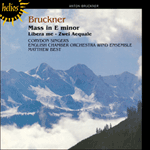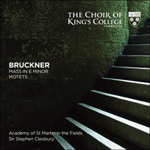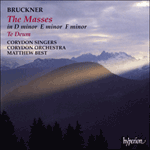
Welcome to Hyperion Records, a British classical label devoted to presenting high-quality recordings of music of all styles and from all periods from the twelfth century to the twenty-first.
Hyperion offers both CDs, and downloads in a number of formats. The site is also available in several languages.
Please use the dropdown buttons to set your preferred options, or use the checkbox to accept the defaults.



The Gloria and Credo, on the other hand, are essentially classical allegros, with contrasts of tempo and style dictated by the text. For the most part Bruckner is revelling in the athletic energy familiar from his great predecessors Haydn and Beethoven, but with textures simpler and more spare and rhythms blunter and more naïve. Both movements are in C major and contain central contrasts, the Gloria having a quiet section on ‘qui tollis peccata mundi’ with typical horn phrases, and the Credo a simple but profound treatment of ‘et incarnatus est’ and ‘Crucifixus’, a stream of perfectly formed, dignified melody of great beauty. The Gloria ends with a short but trenchant chromatic fugato on ‘Amen’, and the Credo (whose main theme anticipates strikingly the sturdy power of the scherzo of the eighth symphony of more than twenty years later) reaches its apex in a broad and mighty cadence.
It is in the Sanctus that Palestrina’s influence (in the form of a quotation from the Missa brevis of 1570) is clearest. A two-part canon is enveloped in eight-part counterpoint as a great crescendo is built. The whole movement lasts only a few minutes but has a power of suggestion out of all proportion to its dimensions; such a slow crescendo as this begins some of Bruckner’s greatest symphonic movements, and the tribute to Palestrina is also a glance to the future, not only Bruckner’s own, but also to such things as the magnificent opening pages of Sibelius’s seventh symphony.
The gentle and subtle Benedictus is in full sonata form, its development deeply modulated and its coda a bright burst on ‘Hosanna in excelsis’. The final Agnus Dei delivers the customary threefold prayer, each time as a crescendo, the last quietened to make way for the hushed ‘dona nobis pacem’, perhaps the most beautiful music in the whole work, which is without doubt the deepest and most concentrated of Bruckner’s Masses.
from notes by Robert Simpson © 1985
D’un autre côté, le Gloria et le Credo sont essentiellement des allegros classiques, où les contrastes de tempo et de style sont dictés par le texte. La plupart du temps, Bruckner se délecte de l’énergie athlétique familière à ses illustres prédecesseurs Haydn et Beethoven, mais avec des textures plus simples et plus austères, des rythmes plus francs et plus naïfs. Les deux mouvements, en ut majeur, contiennent des contrastes centraux, le Gloria présentant une section paisible sur «qui tollis peccata mundi», avec des phrases de cors typiques, et le Credo recelant un traitement simple mais profond du «et incarnatus est» et du «Crucifixus», flot de mélodie digne, parfaitement formée et d’une grande beauté. Le Gloria s’achève par un fugato chromatique bref mais incisif sur «Amen», et le Credo (dont le thème principal anticipe remarquablement, avec plus de vingt ans d’avance, la puissance résolue du scherzo de la huitième symphonie) atteint à son apogée dans une ample cadence imposante.
C’est dans le Sanctus que l’influence de Palestrina est la plus manifeste (avec une reprise de la Missa brevis de 1570). Un canon à deux parties est enveloppé dans un contrepoint à huit parties au fil de la construction d’un grand crescendo. Le mouvement ne dure que quelques minutes, mais son pouvoir de suggestion est complètement disproportionné par rapport à ses dimensions; un lent crescendo comparable commence quelques-uns des plus grands mouvements symphoniques de Bruckner, et l’hommage à Palestrina est également un clin d’œil au futur, aussi bien de Bruckner lui-même que de morceaux comme les magnifiques pages d’ouverture de la septième symphonie de Sibelius.
Le doux et subtil Benedictus, sis dans une forme sonate, voit son développement profondément modulé; sa coda est, pour sa part, un jaillissement étincelant sur «Hosanna in excelsis». L’Agnus Dei final délivre la triple prière habituelle, toujours un crescendo, la dernière étant adoucie pour céder la place au recueilli «dona nobis pacem»—peut-être la plus magnifique de toutes les musiques de cette œuvre, sans doute la plus profonde et la plus intense des messes de Bruckner.
extrait des notes rédigées par Robert Simpson © 1985
Français: Isabelle Battioni
Das Gloria und Credo sind dagegen im wesentlichen klassische Allegros, deren unterschiedliche Tempi und Stile durch den Text vorgegeben werden. Die meiste Zeit ergeht sich Bruckner in der athletischen Energie, die von seinen großen Vorgängern Haydn und Beethoven bekannt ist, doch mit simpleren und weniger komplexen Strukturen sowie schlichteren und naiveren Rhythmen. Beide Sätze stehen in C-Dur, weisen jedoch zentrale Unterschiede auf: das Gloria hat eine leise Passage auf „qui tollis peccata mundi“ mit typischen Hornphrasen, das Credo hingegen eine einfache, aber tiefgreifende Behandlung des „et incarnatus est“ und des „Crucifixus“; ein perfekt gestalteter, würdevoller Melodieverlauf von großer Schönheit. Das Gloria endet mit einem kurzen, aber prägnanten chromatischen Fugato auf „Amen“, während das Credo (dessen Hauptthema auf verblüffende Weise der massiven Heftigkeit des Scherzo der Achten Symphonie, die erst mehr als zwanzig Jahre später entstehen sollte, vorgreift) seinen Höhepunkt mit einer weiten und mächtigen Kadenz erreicht.
Im Sanctus wird der Einfluß Palestrinas (in Form eines Zitats aus Missa brevis von 1570) am stärksten deutlich. Ein zweistimmiger Kanon wird in einen achtstimmigen Kontrapunkt eingebettet, während sich ein großes Crescendo aufbaut. Obgleich der ganze Satz nur wenige Minuten andauert, verfügt er über eine suggestive Ausdruckskraft, die sämtliche Ketten seiner Dimensionen sprengt: mit genau solch einem langsamen Crescendo beginnen auch einige Sätze aus Bruckners größten Symphonien. Auch mit den Ehrerweisungen an Palestrina wird ein Blick in die Zukunft geworfen, nicht nur in Bruckners eigene, sondern auch hinsichtlich der großartigen Eröffnungsseiten der siebten Symphonie von Sibelius.
Das sanfte und leise Benedictus hat volle Sonatenhauptsatzform, seine Durchführung ist stark moduliert, und seine Koda gleicht—auf „Hosanna in excelsis“—einem Feuerwerk. Das abschließende Agnus Dei liefert das traditionelle dreifache Gebet, jedesmal in Form eines Crescendo, von denen das letzte schwächer wird, um dem leisen „dona nobis pacem“, welches vielleicht die schönste musikalische Passage des gesamten Werkes ist, den Weg zu ebnen. Dieses Werk ist zweifelsohne die tiefgreifendste und konzentrierteste aller Bruckner-Messen.
aus dem Begleittext von Robert Simpson © 1985
Deutsch: Anne Steeb/Bernd Müller
 Bruckner: Mass in E minor Bruckner: Mass in E minor‘One of the most beautiful recordings of a choral masterpiece I have ever heard’ (The Sunday Times) ‘Wonderfully atmospheric. I warmly recommend this. Best of the Month’ (Hi-Fi News)» More |
 Bruckner: Mass in E minor & motets Bruckner: Mass in E minor & motetsBruckner’s E minor Mass and a selection of his profoundly beautiful motets were selected by Sir Stephen Cleobury as his last album at King’s, recorded only a few months before his death. Perhaps the deepest and most spiritual of Bruckner’s Masses, ...» More |
 Bruckner: Masses Bruckner: Masses‘Highest honours must go to the outstanding 140-voice chorus who sing with earth-shattering conviction, utmost clarity of diction and enviable precisi ... ‘New standards of excellence … stunning’ (Gramophone)» More |

